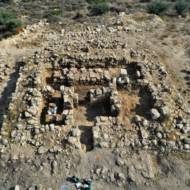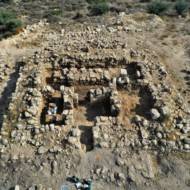
Ahead of Chanukah: Hellenistic Fortress Destroyed by Hasmoneans Uncovered

“The stories of the Maccabees are coming to life before our eyes,” enthused the Israel Antiquities Authority director. “It is extremely exciting.”
By TPS
A Hellenistic fortified structure that was destroyed and burned by Hasmoneans during the Maccabean wars was recently uncovered during excavations in the Judean Shephelah, the Israel Antiquities Authority (IAA) announced Tuesday.
Weapons, burnt wooden beams, dozens of coins and a Hellenistic fortified structure, tangible evidence of a battle between the Hasmoneans and the Seleucids some 2,100 years ago, were unearthed in IAA excavations in Lachish Forest, as part of the Kings of Judah Road project.
Saar Ganor, Vladik Lifshits, and Ahinoam Montagu, excavation directors on behalf of the IAA, said that the site “provides tangible evidence of the Chanukah stories. It appears that we have discovered a building that was part of a fortified line erected by the Hellenistic army commanders to protect the large Hellenistic city of Maresha from a Hasmonean offensive. However, the finds from the site show that the Seleucid defenses were unsuccessful; the building was badly burnt and devastated by the Hasmoneans.”
The excavation revealed a 15×15-meter building planned as a well-fortified unit. The external walls, no less than three meters wide, were built of large stones and had a sloping outer glacis to prevent the wall from being scaled. The inside of the structure was divided into seven rooms, preserved to an exceptional height of roughly two meters.
The excavation uncovered a stairwell leading to a second floor, which was not preserved. The building is estimated to have been about five meters high.
The site is placed on the summit of a high hill commanding a view of the ancient main road, which ran along the Nahal Lachish streambed and connected the coastal plain to the central highland ridge. The building overlooks Maresha, the largest Hellenistic city in the area and the capital of Idumea in the Hellenistic period.
Students majoring in the Ministry of Education’s Land of Israel Studies and Archaeology program from schools in Be’er Sheva, Dimona, and Nitzan assisted in the excavation as part of an IAA program aimed at nurturing awareness of the country’s heritage in the community. The students learn about history through hands-on experience as part of their matriculation studies, thus turning the archaeological excavation into an educational science laboratory.
The excavations were also joined by students from the Asher Ruach Bo pre-military program in Mitzpe Ramon for youth at risk, as part of a week in which the youths make a significant contribution to the community.
During the excavation, the excavators removed thousands of large stones that had collapsed from the upper part of the building. A massive destruction layer, about half a meter thick, was discovered beneath the stones. The layer yielded hundreds of finds, including pottery, slingshots, iron weapons, burnt wooden beams and dozens of coins dated to the late second century BCE.
“Based on the finds and coins, the building’s destruction can be attributed to the Hasmonean leader John Hyrcanus’s conquest of the region of Idumea in around 112 BCE,” the archaeologists said.
The Hasmoneans, whose rebellion against Hellenistic rule and the Seleucid dynasty followed the anti-Jewish decrees of Antiochus IV, waged many battles against the Seleucid army. John Hyrcanus’s conquests, described in the Books of the Maccabees and the accounts of the historian Josephus, led to the Hasmonean state’s southward expansion.
IAA general-director Eli Eskozido stated that “the stories of the Maccabees are coming to life before our eyes. In a few days, we will be celebrating Chanukah, whose central theme is the Hasmoneans’ defeat of the Hellenists, leading to the establishment of the first independent sovereign Jewish entity. The Hasmoneans could have had no idea that 2,000 years later, students living in the State of Israel would be following in their footsteps. It is extremely exciting.”
Zeev Elkin, Minister of Construction and Housing, Jerusalem and Heritage, said that “the impressive discoveries from the excavations in the Lachish region demonstrate the history of our great and wonderful land and the story of Chanukah.”
Minister of Culture and Sports Chili Tropper pointed out that the discovery is “a classic example of how traditional, well-known and well-loved stories become part of the historical and archaeological record. The building’s excavation reflects the glorious roots of the Jewish people in the Land of Israel and brings the Hanukkah stories to life.”
The site will undergo conservation and will be opened to the general public as one of the sites along the Kings of Judah Road, which is currently under development.
Bring Chanukah Joy to Israeli Soldiers – Send Winter Care Packages!
We are honored to thank the young men and women of the IDF who risk their lives every day to defend the citizens of Israel.
Join us in sending holiday care packages and personal notes of support to Israeli soldiers who are out in the cold all day.
Warm up a soldier’s heart with essential winter wear including fleece jackets, hats, gloves and more. Keep an entire unit warm!
THE SOLDIERS REALLY APPRECIATE YOUR LOVE AND CONCERN!
Click Here to Send Your Gift and Personal Note to Israeli Soldiers
The post Ahead of Chanukah: Hellenistic Fortress Destroyed by Hasmoneans Uncovered first appeared on United with Israel.
United with Israel
